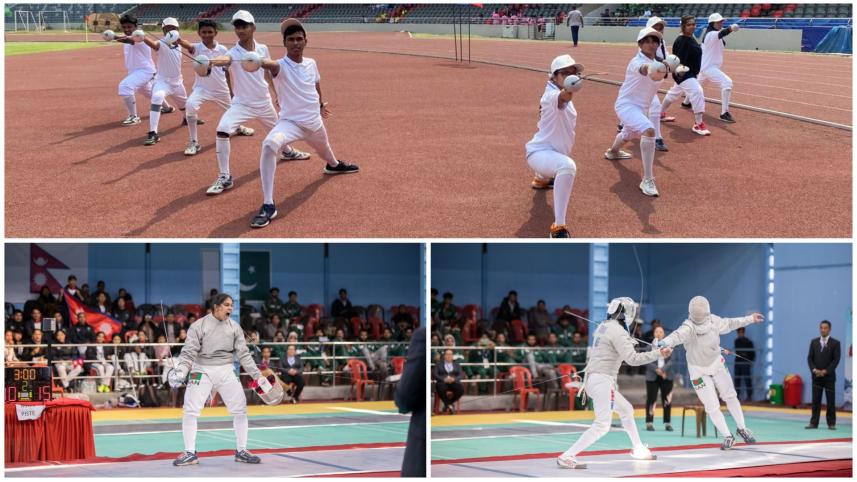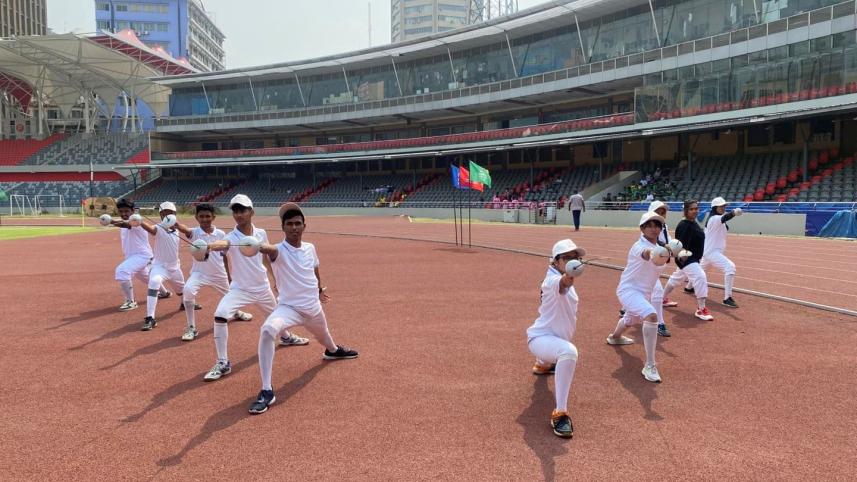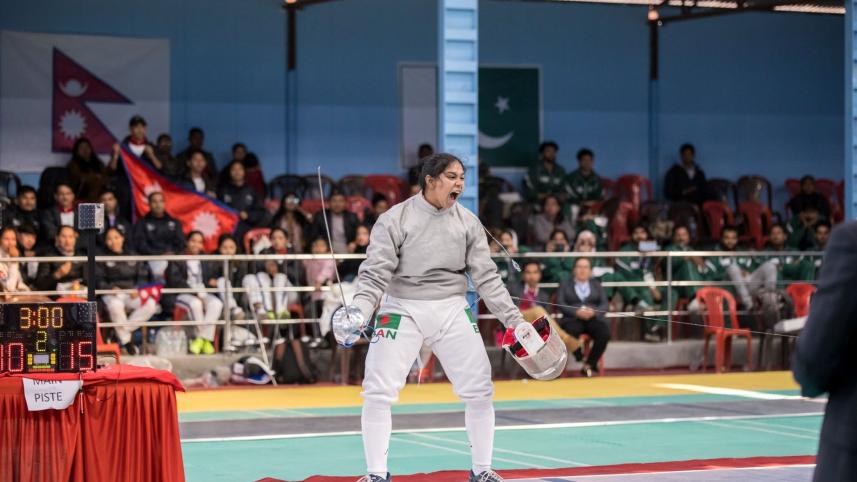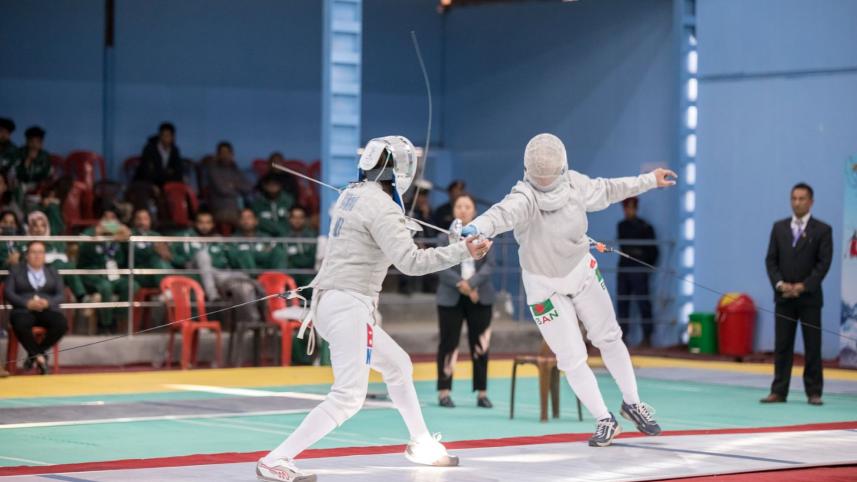Blades dancing in the shadows

As the afternoon light softened over Dhaka, the Shaheed Suhrawardy Indoor Stadium in Mirpur suddenly echoed with the metallic clash of steel.
Upon stepping closer, one would see two young women facing each other, their faces hidden by black mesh masks, dressed in white, holding slender glistening blades. They take guard with an "en garde" stance, freeze for a heartbeat, then surge forward at the call of "Allez!"
Steel cuts the air like lightning slicing through clouds -- no blood, no violence. Only strategy, rhythm, and the science of signals. The sport is fencing.
In a country where sport is almost synonymous to cricket or football, fencing feels like a submerged tale from distant seas -- unseen, unknown; yet stirring a faint vibration, like the soft hum of a tanpura.
Among those preparing at the corner of the venue was Fatematuz Zohra Jaimah, a student of BAF Shaheen School and College. Adjusting her lamé (pronounced lah-may) jacket, she said softly, "When I first held a foil, it felt like I was writing poetry. Rhythm defined the attack. That poetic voice may not have sustained, but the feeling remains. I practise quietly; maybe one afternoon, with an international medal, I will find that rhythm again.

The tricky thing about fencing is that there are no secrets. Once you get on the strip… it comes down to a battle of minds, really.
"While swapping feet at will to maintain agility, the mind also has to keep up with the dynamic beats of tactics."
The genesis of fencing may be traced back to Europe's cloudy fields, but its language requires no translation. "Right of way" may sound like legal jargon, but in truth it is like cinematic dialogue in a play -- who speaks first, who pauses, where the interval happens. "Halt" stops the action, "Allez" reignites it. A touch on a designated target sparks a flash of green or red on the scoring box, and for a spectator, a quick jolt of excitement. In Mirpur, without a crowd, that jolt remains locked within the fencers' hearts.
Stationed nearby, coach Shahidul Islam of Bangladesh Ansar explained the three events: the precision of foil, the patience of épée, the flair of sabre. Why has the sport not spread at the grassroots? He sighed: "Wishing is not enough; structure is needed. The gear -- mask, lamé, body wire, electric sword -- is specialised and costly, with maintenance required too. You need trained coaches and safe indoor spaces."

On a street corner near New Market, college student and cricket lover Nafis laughed: "Swords? I've seen them in films, but never on a playing field." His friend Shamim showed more curiosity: "If it's safe, I'd try. But where would I learn?" Their questions mirror society's specticism in the face of the unfamiliar. A parent in Dhanmondi, Mamta Begum, said: "If children can play safely, I have no objection. The problem is, we don't even hear about it. Who will teach, and where?"
Head coach Abu Zayed Chowdhury of the Bangladesh Fencing Federation pointed to small nations that embraced the sport -- Hungary, South Korea. "Here, our sporting culture is narrow. Media, society, playing fields -- all revolve around a few games. For others, space exists, but not light. Fencing demands discipline, focus, cognitive speed -- qualities that support education as well. If schools and universities had clubs, in ten years the picture would change."
Far from Dhaka, in a village by the Dhaleshwari River, two children stood facing each other in a yard. They had drawn a narrow line on the ground for their imaginary piste. With slim PVC pipes in hand, they lunged and retreated, laughter mixing with sharp concentration. In their imagination, they whispered commands: "Advance!", "Retreat!", "Lunge!" Then they froze, eyes meeting curiously, as if both said together: "Allez!" In such small games lie the maps of greater journeys, for fencing is not a contest of strength but of timing and decision. Who reads the feint first? Who senses the rhythm of distance? Who knows that the best defence can be the perfect attack?

The story of fencing in Bangladesh circles back to Major Kamrul Islam (retd), president of the federation, who first introduced the sport in 2007 after leaving archery. Despite political interruptions, he returned and oversaw tournaments, including the recent National Championship. "Bringing fencing here in 2007 was a challenge," he said. "The Indian federation helped by sending coaches, some at no cost. Slowly, schools and colleges joined in. At first, people were afraid, but once they knew it was safe, they came forward. Later, the armed forces embraced it, and clubs followed." In 2016, Bangladesh made its debut at the South Asian Games -- and returned with 11 medals.
At the latest nationals, Sumaiya Yasmin from Lalmatia School and College, trained through a civilian club, Bengal Academy, won gold in sabre. The army have since offered her a place. "I come from a poor family," she said. "Getting equipment outside the armed forces is very difficult. If we had better support from the federation or sponsors, we could go further. Our local coaches are good, but international expertise would take us to another level."
Even so, the passion is undeniable. Emily Rai Isha, a nurse, won a medal at the nationals. "I fell in love with the game the moment I first tried it," she said. Another fencer, Nazira Khatun, summed it up differently: "There is something royal about this sport."
When the discussion turned to sponsorship, Rejaur Rahman Sinha, head of the media committee of the federation, said, "Previously, we had always relied on in-house sponsors, but for this year's Nationals, we've got Suzuki on board. It's a huge step for us. Having such a well-known brand associated with us is truly inspiring. Suzuki has also assured us that their support will continue in the future." Meanwhile, Major Kamrul added: "This time, at the South Asian Games, those who win gold will receive a motorbike from Suzuki, while the women's gold medallists will get scooters."
One night, rain beat down on tin roofs, sounding like blades striking. The city seemed to ask itself: will we remain content with familiar games, or will we awaken to a new discipline, to the soft flash of the sword? The answer has not yet been spoken, but the preparation has begun. In Mirpur's indoor hall, each step, each whispered "Allez!", is proof. Fencing is no longer entirely unknown. And those who pursue it -- quietly, patiently -- are our unknown warriors, learning not just to strike, but to pause, and to triumph through restraint, while history whispers that swordfighting has long been woven into the tales of this region.
HIGHLIGHTS
• Three weapons, three styles:
o Foil: Precision is king. Only the torso counts as a target, and a touch is a whisper of skill rather than force.
o Épée: Patience pays off. Every part of the body is a target, and hesitation can cost you dearly.
o Sabre: Lightning on the piste. Fast, aggressive, and dazzling -- speed and edge rule the bout.
• From duels to sport:
What began on the cloudy battlefields of Europe became a disciplined sport with lighter blades, protective gear, and electronic scoring. Fencing turned duelling into a chess match of steel.
• Olympic legacy:
Present at every modern Games since 1896, fencing has grown into a stage for men and women to test strategy, reflex, and nerves. Women first entered with foil in 1924 and currently all three weapons are contested globally.
• Champions and powerhouses:
Legends like Edoardo Mangiarotti (Italy), Christian d'Oriola (France), Valentina Vezzali (Italy), and Áron Szilágyi (Hungary) set the standard. Powerhouses include Italy, France, Hungary, with South Korea, China, and the USA emerging as modern forces.
• Local promise:
The Bangladesh Fencing Federation has been nurturing the sport since 2007. Participation is steadily spreading beyond Dhaka, with schools, clubs, and youth taking up the challenge.
• Why give fencing a go?
Fencing is called "physical chess" for a reason. It hones reflexes, agility, and strategic thinking. On the piste, timing is everything -- sometimes the slow and steady will outwit the bold.
BANGLADESH'S FENCING JOURNEY:
• Fencing was introduced in Bangladesh in 2007, with support from India.
• Breakthrough came at the 2016 South Asian Games, with Bangladesh winning 11 medals on debut.
• There are currently around 450 registered players, about 60 percent of them male.
• Bangladesh has 20 clubs, including 4 outside Dhaka.
• Five major tournaments are held annually: the National Championship, Cadet & Junior Championship, President's Cup, Victory Day Cup, plus one additional event.
• At the 2019 South Asian Games, Bangladesh secured 11 medals in fencing: 1 gold, 3 silver, and 7 bronze.



 For all latest news, follow The Daily Star's Google News channel.
For all latest news, follow The Daily Star's Google News channel.
Comments